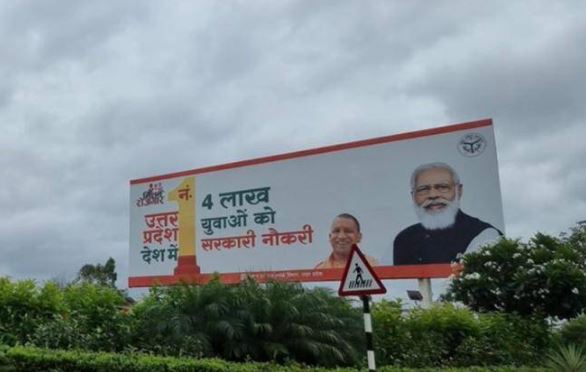
For the past one year, the hoardings on all roads leading to the suburbs of the national Capital falling in Uttar Pradesh displayed the achievements of the UP government. It’s estimated that vehicles in lakhs cross borders into the neighbouring Gautam Budha Nagar (Noida) and Ghaziabad districts.
These hoardings were of course hired by Uttar Pradesh government to target these daily travelers who are not restricted to just the two districts above. At least a million people cross over on a daily-basis from UP into the national Capital for work.
They come, in addition to Noida and Ghaziabad, from the districts of Baghpat, Shamli, Meerut, Hapur, Amroha, Bulandshahr, Aligarh, Hathras and Mathura. That’s more than half of the 15 districts, which makes up politically volatile western Uttar Pradesh.
These daily passengers travel to Delhi variously by road, metro and rail. Keeping this in view, the Uttar Pradesh government occupied all the advertising space on these routes to showcase its attainments. It was necessary to mollify that section of voters of the poll-bound state who suffered worst by the year-long agitation of the farmers, who laid siege of the national Capital.
The blocking of the highway and lack of will on the part of the UP and Union governments, both ruled by the BJP, to clear the siege caused unprecedented harassment for the daily commuters to the national Capital from these regions. They wasted hundreds of hours and gallons of diesels negotiating the jams for year-long.
Unlike the era of former Prime Minister Chowdhary Charan Singh, western UP today is not only about kisans (farmers) but also about the cosmopolitan population which has come to occupy the condominiums built in thousands in sub cities like Noida, Greater Noida and colonies of Ghaziabad district like Indirapuram, Vaishali and Kaushambi bordering the national Capital.
In fact in the past two decades, especially after the crackdown by the Supreme Court in the MC Mehta case, majority of the industries too of the national Capital, including the printing presses of all the major publications, have shifted base to the industrial estates of Uttar Pradesh.
Following the delimitation of seats in 2008, the assembly polls since 2012 in Uttar Pradesh has for certain given a ‘national’ flavour to several assembly seats in these districts. No wonder the Bharatiya Janata Party swept assembly polls in all these districts including those with overwhelming cosmopolitan population.
One of the reasons for the ‘Delhi-type-voter’, as they are referred to in the local parlance, going for the BJP was the anguish they had with the private builders. The real estate policies of the Samajwadi Party governments led by Mulayam Singh Yadav in 2002 and Akhilesh Yadav in 2012 and Bahujan Samajwadi Party government led by Mayawati in 2007, while spurred growth in realty sector, it left many investors paupers.
The worst affected were salaried-class and small business entrepreneurs who took bank loans to buy home in these apartment projects. While they were made to pay the bank instalments from the day of disbursement of loans, they were also forced to continue paying rent as occupancy in these projects were delayed.
The BJP government on coming to power promised strong action against the defaulting builders. While they did rationalize the real estate policies, their role in expediting the projects was not visible. Whatever relief came for investors it was by the way of the Supreme Court taking the matter into its own hands and monitoring the projects.
Nevertheless to the credit of Yogi Adityanath, he doesn’t face the allegation of being soft to Noida-Ghaziabad builders, which his predecessors faced. Would this be enough to see a similar sway of the BJP among ‘Delhi-type-voters’, a question to which probably all contesting parties want a quick answer.
(The writer is Author and President, Centre for Reforms, Development & Justice)

